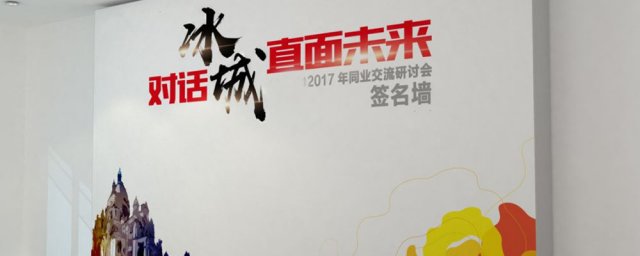借用继承
Data visualization is a great way to celebrate our favorite pieces of art as well as reveal connections and ideas that were previously invisible. More importantly, it’s a fun way to connect things we love — visualizing data and kicking up our feet for a movie night. All week, Nightingale is exploring the intersections between data visualization and all kinds of entertainment.
数据可视化是庆祝我们最喜欢的艺术品以及揭示以前不可见的联系和想法的好方法。 更重要的是,这是连接我们喜欢的事物的一种有趣方式-可视化数据并为电影之夜踢起脚来。 整个晚上,夜莺都在探索 数据可视化与各种娱乐之间 的 交集 。

A few months ago I was averaging three museum visits a week, and now I can average three virtual visits in an hour, provided I’m graced with a stable internet connection. While jumping from collection to collection, I’ve held a rather critical eye to the digital museum realm. The trick, however, isn’t to search or expect the same experience that an in-person visit would provide, but be open to a new and different one. Similarly, museums should keep the latter in mind when developing their own digital experiences. I’ll explore the various strategies museums use in terms of their online presence while highlighting digital collections and experiences I find especially ‘successful.’ If you’re eager to skip to the experiences themselves, there’s a list and the bottom of the article, and I’ll never know if you just scroll to the end.
几个月前,我平均每周工作三个馆参观,现在我可以平均在一个小时内三个虚拟访问,提供我与一个稳定的互联网连接增光。 从一个收藏到另一个收藏,我对数字博物馆领域持相当批判的眼光。 但是,诀窍不是要搜索或期望获得与亲自访问一样的体验,而是要接受新的和不同的体验。 同样,博物馆在发展自己的数字体验时也应牢记后者。 我将探讨博物馆在网上展示方面使用的各种策略,同时重点介绍我认为特别“成功”的数字馆藏和体验。 如果您急于跳到自己的经历,这里有一个列表和文章的底部,我永远不会知道您是否滚动到最后。
走向数字化 (Going Digital)
The COVID-19 pandemic has forced museums to reevaluate their strategy from a primarily physical experience into an online one. While digital collections existed long before the novel coronavirus, more and more digital museum content has been surfacing it began. As I will explain later, providing online access to a museum’s collections and data is one thing, but developing a curated experience out of it is another. Unfortunately, it often seems as though museums take an approach that emerges from the physical exhibition, and use a similar structure to express it online. Rather than attempt to reproduce the in-person museum experience into an unequivocal medium, the internet, museums should seek to create experiences unique to the digital realm. Museums should ask themselves what digital tools can be used to display their collection, seeking frameworks and stories beyond an image-based list, or defaulting to an exhibition format. The digital realm has enough unique attributes to be treated separately.
COVID-19大流行迫使博物馆重新评估其策略,从最初的物理体验转变为在线体验。 尽管数字收藏品早于新型冠状病毒存在,但越来越多的数字博物馆内容开始浮出水面。 正如我将在后面解释的那样,提供对博物馆馆藏和数据的在线访问是一回事,而从中开发策展的体验则是另一回事。 不幸的是,博物馆似乎常常采用从实体展览中出现的方法,并使用类似的结构在网上进行表达。 博物馆不应该试图将现实的博物馆体验复制到明确的媒体(互联网)上,而应该寻求创造数字领域特有的体验。 博物馆应该问自己:可以使用哪些数字工具来展示其收藏品,在基于图像的列表之外寻找框架和故事,或者默认使用展览形式。 数字领域具有足够的独特属性,需要单独处理。
As I briefly mentioned in a previous article on how data visualization can enhance the museum experience, digitalizing collections is a first and important step toward this end goal. It is much easier to pull new relationships and ideas from your collection if you’re equipped with data visualization tools and therefore the means to experiment freely with collections. While this is possible with a standard excel sheet, it is arguably more difficult and time-consuming to find such relationships, as excel sheets demand more manual work and a lot of uninspiring patience. Digitalization should be embedded in the museum’s strategy from the get-go, outlining the intended purpose of the digital collection.
正如我在上一篇有关数据可视化如何增强博物馆体验的文章中所简要提到的那样 ,对馆藏进行数字化是实现这一最终目标的第一步,也是重要的一步。 如果您配备了数据可视化工具,那么可以轻松地从集合中获取新的关系和想法,因此可以自由地尝试集合。 尽管使用标准excel表格可以做到这一点,但是找到这样的关系无疑会更加困难和耗时,因为excel表格需要更多的人工工作和很多令人振奋的耐心。 数字化应该从一开始就嵌入到博物馆的战略中,并概述数字收藏的预期目的。
Derby Museums is one example of a museum collective that implemented a digital strategy. Their brainstorming session notes (an image excerpt is featured below) illustrate the benefits of digitalizing collections and the many faces it can take. To review the objectives:
德比博物馆 ( Derby Museums)是实施数字策略的博物馆集体的一个例子。 他们的集思广益的会议记录(下面是图片摘录)说明了对馆藏进行数字化的好处以及所能拍摄的许多面Kong。 审查目标:
Global accessibility online: can easily search, share and use collections
在线全球可访问性 :可以轻松地搜索,共享和使用收藏集
Storytelling: create engagement opportunities whether that be in the form of education, apps etc.
讲故事 :以教育,应用等形式创造参与机会。
Management of digital assets: keep the collection organize and accounted for, preserving content that risks degradation
数字资产管理 :保持馆藏的组织和核算,保留有降级风险的内容
Monetizing collection: can demonstrate the collection’s value or even generate revenue
货币化收藏 :可以展示收藏的价值,甚至产生收益
The objectives are made possible by the digital collection, which serves as their linkage and heart.
这些目标是通过数字收藏品实现的,这些收藏品是它们的链接和核心。

With that said, museums have established various digital experience tiers while moving online that stem from the online collection. From basic to more elaborated:
话虽如此,博物馆在迁移到网上时已经建立了各种数字体验层,这些层源于在线收藏。 从基本到详细:
Online digital collections with basic search features: users can explore the digital collections on their own by searching or browsing.
具有基本搜索功能的在线数字馆藏:用户可以通过搜索或浏览自行浏览数字馆藏。
2. Online digital collections with a guided experience: like above, users can explore digital collections on their own, but there are additional features such as color or time period filters for “guided wandering.” These types of search functions group works in a similar fashion that an exhibition would, with the added benefit of being more malleable.
2. 具有指导性体验的在线数字馆藏:像上面一样,用户可以自行浏览数字馆藏,但是还有其他功能,例如用于“引导性游荡”的颜色或时间段过滤器。 这些类型的搜索功能组的工作方式与展览类似,但具有更大的延展性。
3. Virtual tours with google or audio tour (a possible intermediary step): users can follow a tour, in an attempt to mirror the in-person experience.
3. 带有Google或语音导览的虚拟导览(可能的中间步骤):用户可以跟随导览,以尝试亲身体验。
4. Interactive experiences/applications: users can engage and interact with aspects of the collection.
4. 互动体验/应用程序:用户可以与馆藏的各个方面进行互动。
Each seems to build off of one another: in other words, I have yet to find museums that have made interactive experiences out of their collections but don’t have an online digital collection for viewing. Online digital collections seem to be the groundwork for more elaborate applications. The next two sections will consider online digital collections, then the interactive experiences that can emerge from them.
彼此之间似乎是相互依存的:换句话说,我还没有找到能够从其收藏中获得互动体验但没有在线数字收藏的博物馆的博物馆。 在线数字馆藏似乎是更复杂应用程序的基础。 接下来的两个部分将考虑在线数字馆藏,然后是从中获得的互动体验。
在线数字馆藏 (Online digital collections)
While there is diversity in the style of online digital collections—from basic search methods to the more creative—the most rudimentary appear like a visual spreadsheet. Apparently, I’m not alone with this impression. In 2015, Mitchel Whitelaw, who works with museums and libraries alike to digitalize and visualize their collections, published an article in Digital Humanities Quarterly called “Generous Interfaces for Digital Cultural Collections,” which argues that:
从基本的搜索方法到更具创造性的在线数字馆藏样式虽然多种多样,但最基本的看起来就像是可视电子表格。 显然,我并不孤单。 2015年,与博物馆和图书馆等机构合作以对馆藏进行数字化和可视化处理的Mitchel Whitelaw在Digital Humanities Quarterly上发表了一篇名为“ 数字文化馆藏的慷慨接口 ”的文章,其中指出:
“[…] search, as the dominant interface to our cultural collections, is inadequate. Keyword search is ungenerous: it demands a query, discourages exploration, and withholds more than it provides. This paper argues instead for generous interfaces that better match both the ethos of collecting institutions, and the opportunities of the contemporary web. Generous interfaces provide rich, navigable representations of large digital collections; they invite exploration and support browsing, using overviews to establish context and maintain orientation while revealing detail at multiple scales.”
“ […]作为我们文化收藏的主要接口,搜索是不够的。 关键字搜索是无用的:它需要查询,不鼓励探索,并且不提供所提供的更多功能。 相反,本文认为,慷慨的界面可以更好地匹配收集机构的精神和当代网络的机会。 慷慨的界面可提供大型数字馆藏的丰富导航视图; 他们邀请探索和支持浏览,使用概述来建立上下文并保持方向,同时以多个尺度揭示细节。”
To illustrate his first point about keyword searches, I’ve included an image below taken from the website of London’s Victoria & Albert Museum. I invite you to click here to try it out for yourself.
为了说明他关于关键字搜索的第一点,我在下面提供了一张图片,该图片取自伦敦维多利亚和阿尔伯特博物馆的网站。 我邀请您单击此处亲自尝试。
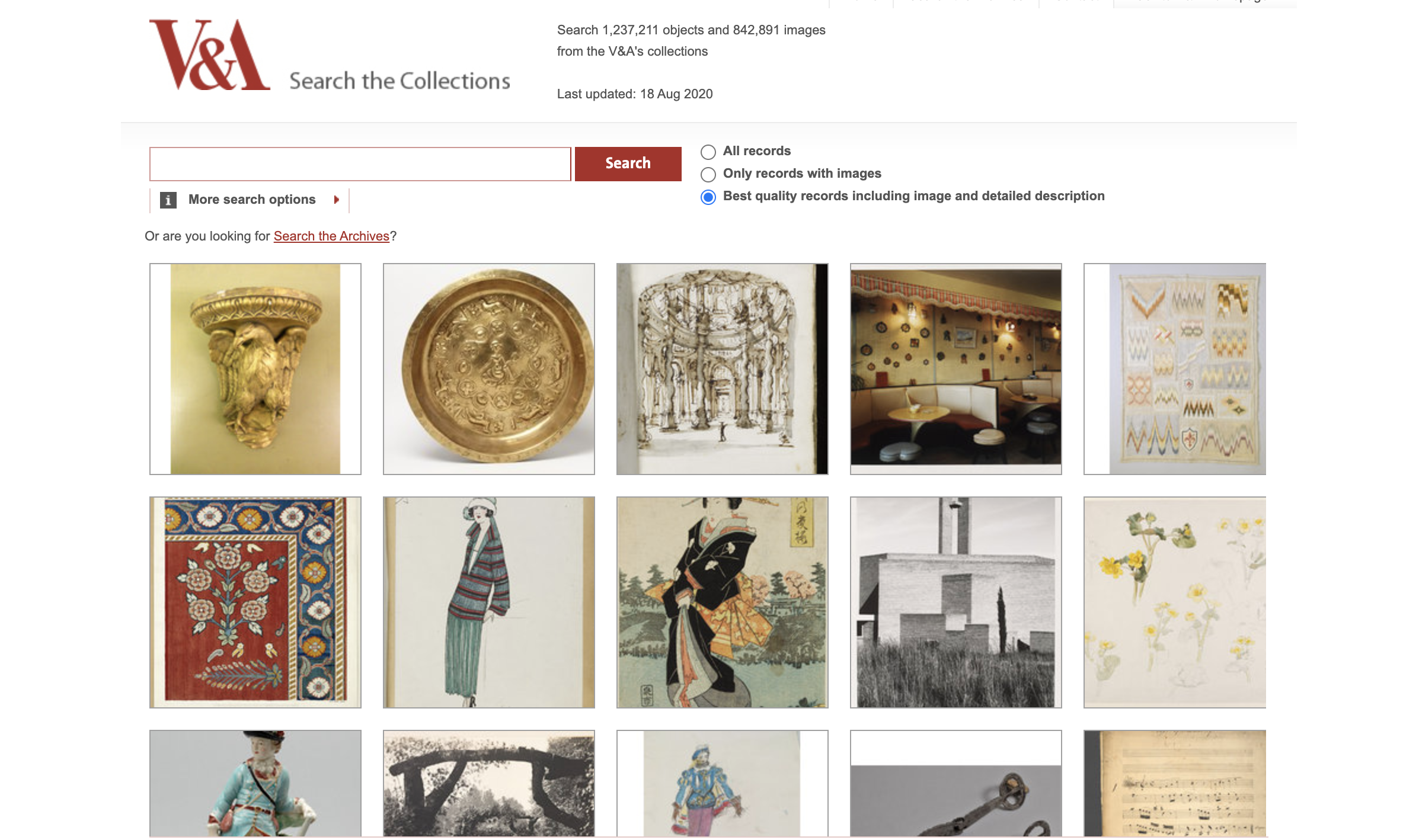
Faced with this landing page, what is your first impression? How would you interact with it? Is there a story that’s being told? While the below interface allows more exploration than a simple keyword search without images, it remains unfriendly for those hoping for guided exploration. You could argue that a loose story thread is fabricated when you type in a search word, but there is no guide or curation involved other than the one you are constructing yourself.
面对着陆页,您的第一印象是什么? 您将如何与之互动? 有没有讲故事? 尽管与没有图像的简单关键字搜索相比,下面的界面可以进行更多的探索,但对于那些希望进行指导探索的人来说仍然不友好。 您可能会争辩说,输入搜索词时会捏造一个松散的故事线索,但是除了您自己构建的那个故事以外,没有涉及任何指南或策展。
I am not trying to undermine digital collections, I am merely hoping to engage conversation on visualizing and navigating through digital collections to the full extent that current technologies allow. Digital collection interfaces like this one take up only a tiny stroke of what’s possible in the digital landscape.
我并不是要破坏数字馆藏,我只是希望就当前技术允许的范围内的可视化和导航进行对话。 像这样的数字采集接口仅占用了数字领域中很小的一笔。
This type of interface for collections, therefore, seems better suited for researchers, or those who have an idea of what kind of work they are looking for in a given collection. Nevertheless, other museums have taken the standard digital collection interface and tweaked it, with amusing results.
因此,这种类型的馆藏接口似乎更适合研究人员或那些对特定馆藏正在寻找何种工作有想法的人。 尽管如此,其他博物馆还是采用了标准的数字收藏界面并对其进行了调整,从而获得了可喜的结果。
One notable example is the Art Institute Chicago that includes a variety of filter features such as color, places, subjects, etc., as illustrated in the picture below. Indeed, customizing search filters by adding a few “non-traditional” options is an easy fix toward a more curated experience out of a standard searchable digital collection, a point I’ll elaborate on in the following section.
一个著名的例子是芝加哥艺术学院 ,其中包括各种滤镜功能,例如颜色,位置,主题等,如下图所示。 确实,通过添加一些“非传统”选项来自定义搜索过滤器很容易解决,从而可以从标准可搜索数字馆藏中获得更丰富的体验,这一点我将在下一节中详细说明。

互动体验 (Interactive Experiences)
After the work of digitalizing collections is complete, a laboratory or playground of opportunity emerges, depending on your perspective. Data can be manipulated, filtered, and ultimately used to tell stories. These are experiences that stem from digital collections and are written in the language of the internet. Some tours have even left Google’s street-view, as used by the Guggenheim, and upgraded to virtual reality. Experiences like VersailleVR: the Palace is yours and The Dawn of Art: a journey through the Chauvet cave attempt to replicate the in-person experience but do so at the full extent of modern-day technology. The caveat is that you need to own a computer and a VR headset.
馆藏数字化工作完成后,根据您的观点,会出现一个实验室或机会游乐场。 数据可以被操纵,过滤并最终用于讲述故事。 这些是从数字馆藏中获得的经验,是用互联网语言编写的。 一些游览甚至离开了古根海姆(Guggenheim)使用的Google街景,并升级为虚拟现实。 诸如VersailleVR:宫殿就是您的体验, 而艺术的曙光:穿越Chauvet洞穴的旅程试图复制亲身体验,但要在现代技术的最大范围内进行。 需要注意的是,您需要拥有一台计算机和一台VR耳机。
With the above exceptions that aim for a literal translation of museum visits, an advantage of interactive museum applications is that they are unique to the digital sphere. A prime example is the British Museum’s The Museum of the World application.
除了上述旨在对博物馆参观进行字面翻译的例外,交互式博物馆应用程序的一个优点是它们对于数字领域是唯一的。 一个典型的例子是大英博物馆 的世界博物馆应用程序。
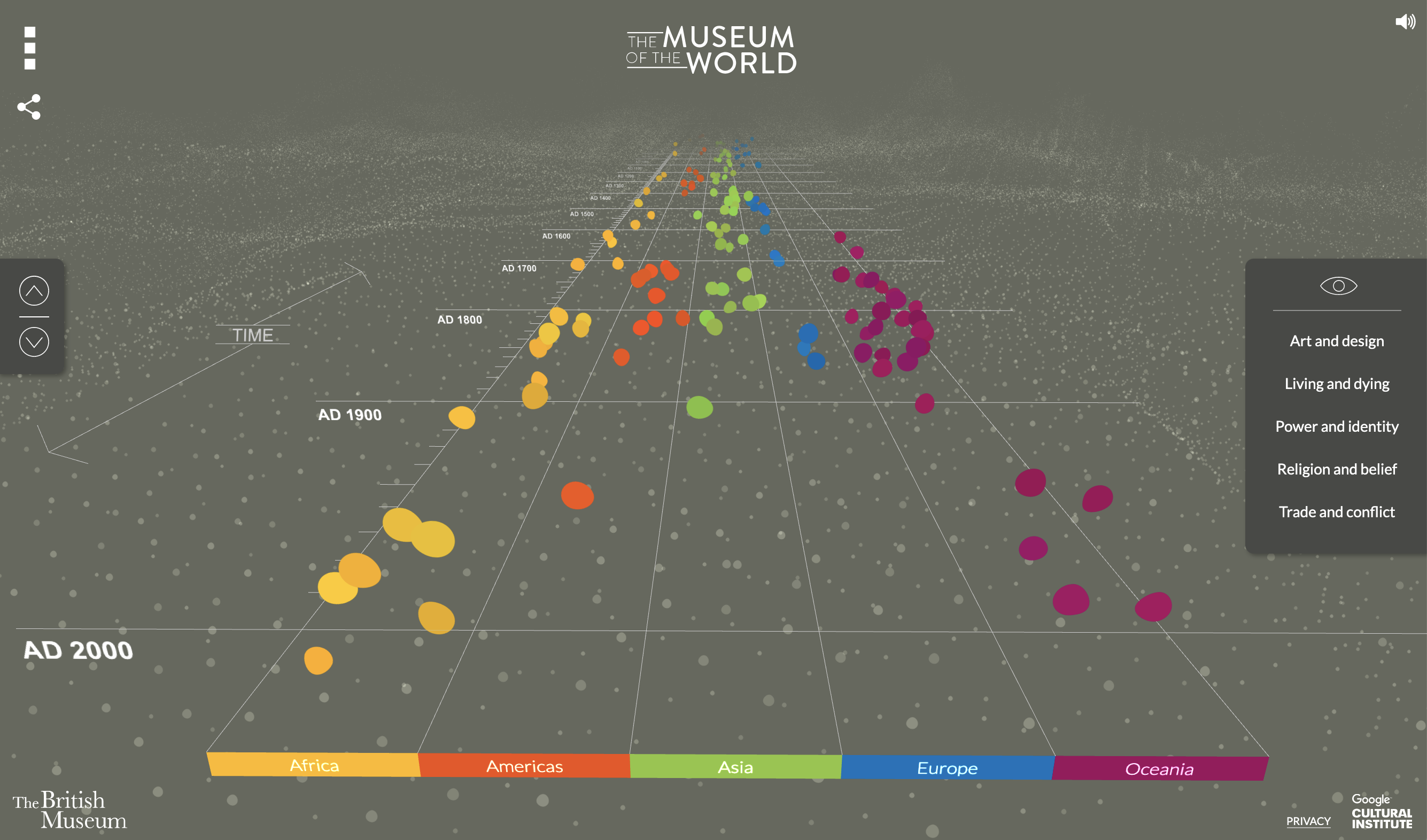
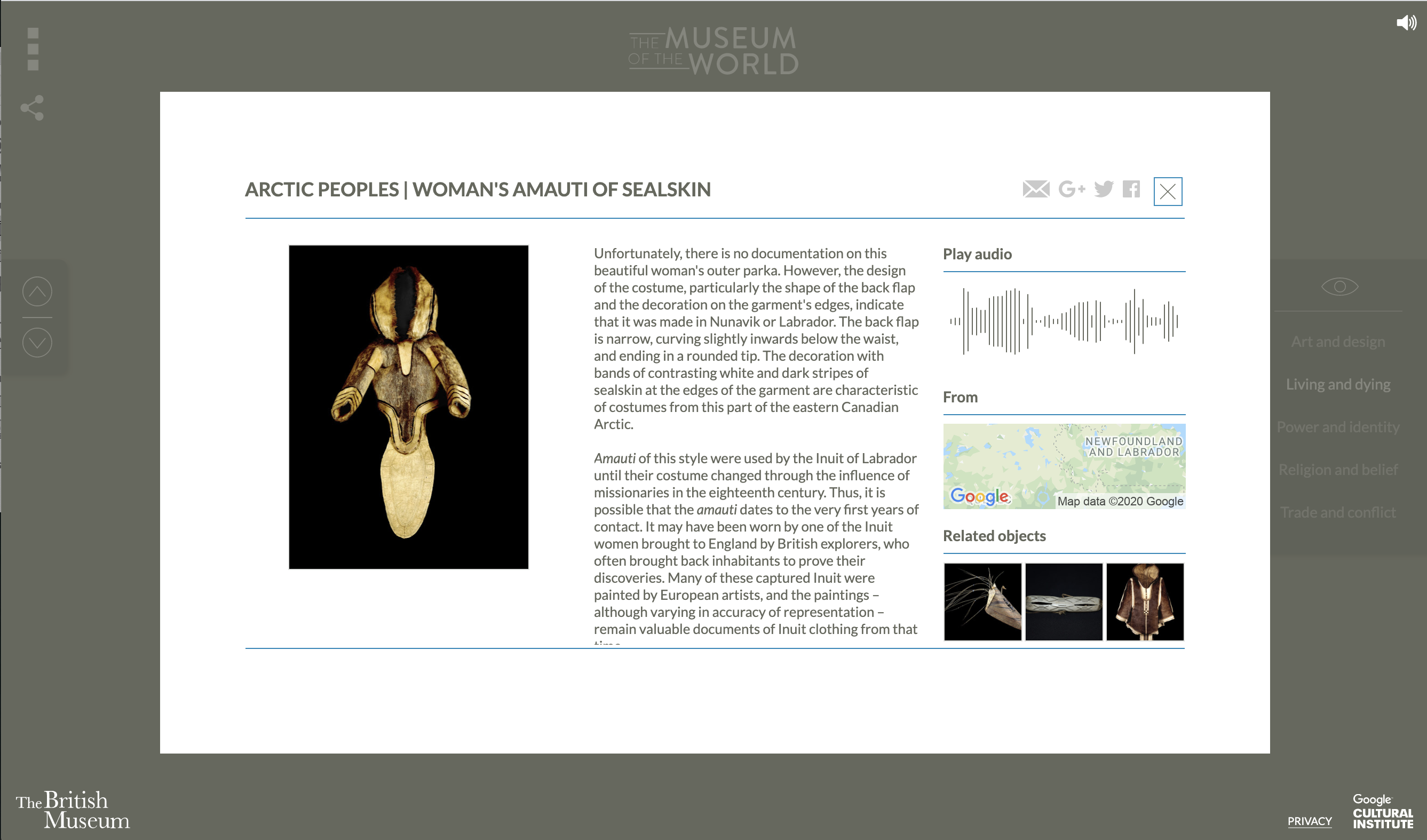
While implementing the standard storytelling thread of chronology, this interactive application allows the user to plunge through time with their mouse or trackpad to click on elements that bring up a multimedia page complete with a description, map of the area in question, audio, and similar objects. Although the whole experience might echo the structure of exhibitions, it is made in the language of the internet with multimedia features that might be lacking in a standard exhibition.
在实现按时间顺序排列的标准叙事线程时,此交互式应用程序允许用户使用鼠标或触控板在时间上跳入,单击显示多媒体页面的元素,其中包括描述,所关注区域的地图,音频等。对象。 尽管整个体验可能会与展览的结构相呼应,但它是使用互联网语言制作的,具有标准展览可能缺少的多媒体功能。
The Museum of the World is actually a product of Experiments with Google, an initiative that contains a variety of creative programs that artists have outputted using museum collections, going beyond collection lists and virtual tours. It represents an instance of how open-source digital collections can expand digital experiences and spur innovation. I admittedly spent a few hours testing all of the applications on Experiments with Google that piqued my interest. I started with Beyond Scrolls & Screens, which analyzes Japanese folding screens and scrolls in a comic book-like format and at least one of those hours was spent fulfilling my childhood dream of studying hieroglyphics with Fabricius. The beauty lies not only in the interactivity, but Experiments with Google pools together pieces from collections around the world, binding them together in a coherent story.
世界博物馆实际上是Google实验的产物,该计划包含艺术家创作的各种创意程序,这些程序使用博物馆的收藏品进行创作,不仅限于收藏清单和虚拟游览。 它代表了开源数字馆藏如何扩展数字体验并促进创新的一个实例。 我承认我花了几个小时在Google的“实验”上测试了所有应用程序,这激起了我的兴趣。 我从Beyond Scrolls&Screens开始,它以类似漫画的格式分析日式折叠屏风和卷轴,其中至少有一个小时用于实现我童年时与Fabricius学习象形文字的梦想。 美丽之处不仅在于互动性,还有Google的实验将来自世界各地的收藏品汇集在一起,将它们捆绑在一起形成一个连贯的故事。
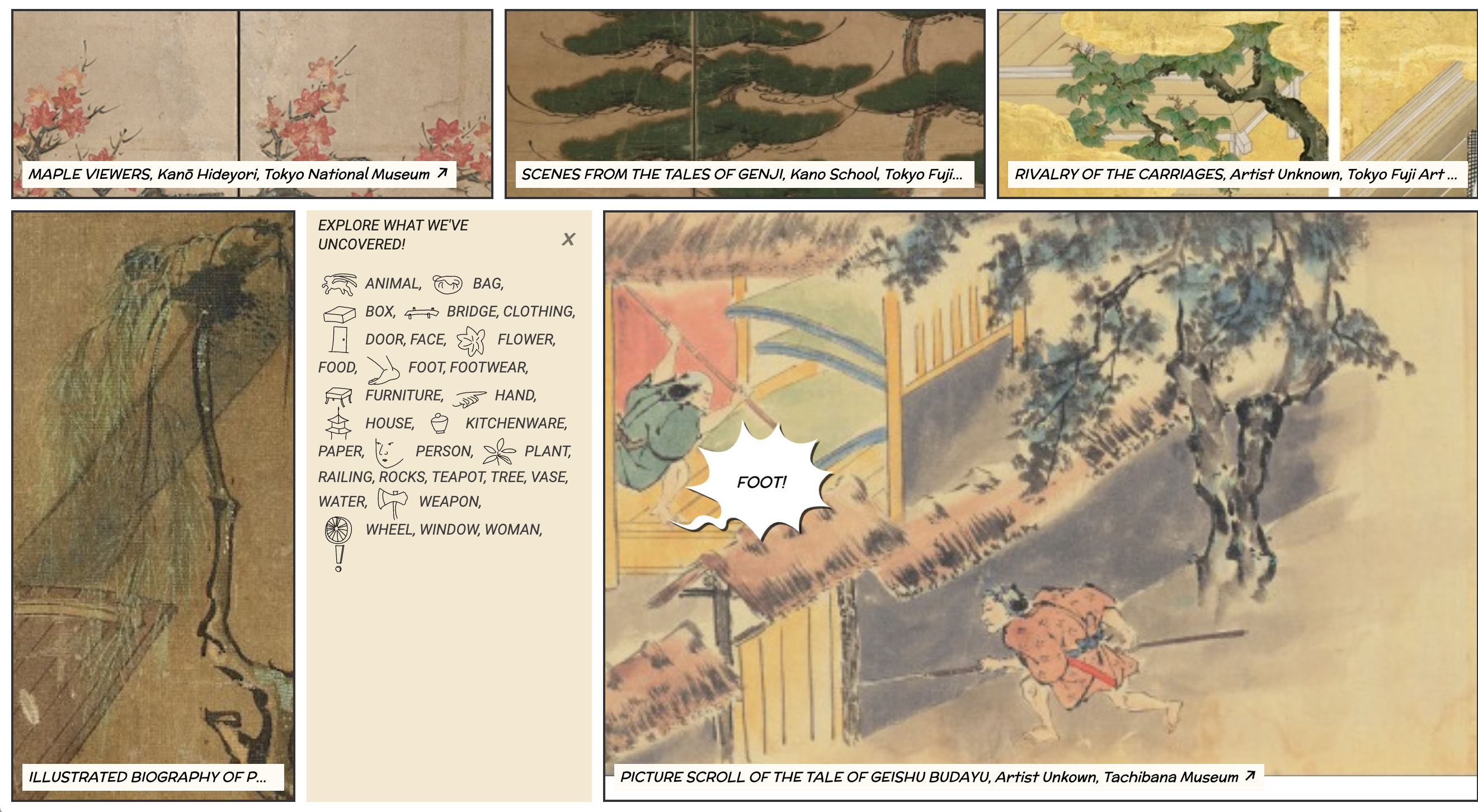
Universities have also produced experimental applications to visualize art. One of my favorites is a collection from the University of Potsdam in Germany. One application, COINS: A journey through a rich cultural collection invites the user to explore historical coins from the Münzkabinett Berlin’s collection.
大学还产生了实验应用程序以可视化艺术。 我的最爱之一是德国波茨坦大学的收藏 。 一个应用程序, 硬币:穿越丰富的文化收藏的旅程邀请用户探索柏林Münzkabinett收藏的历史硬币。
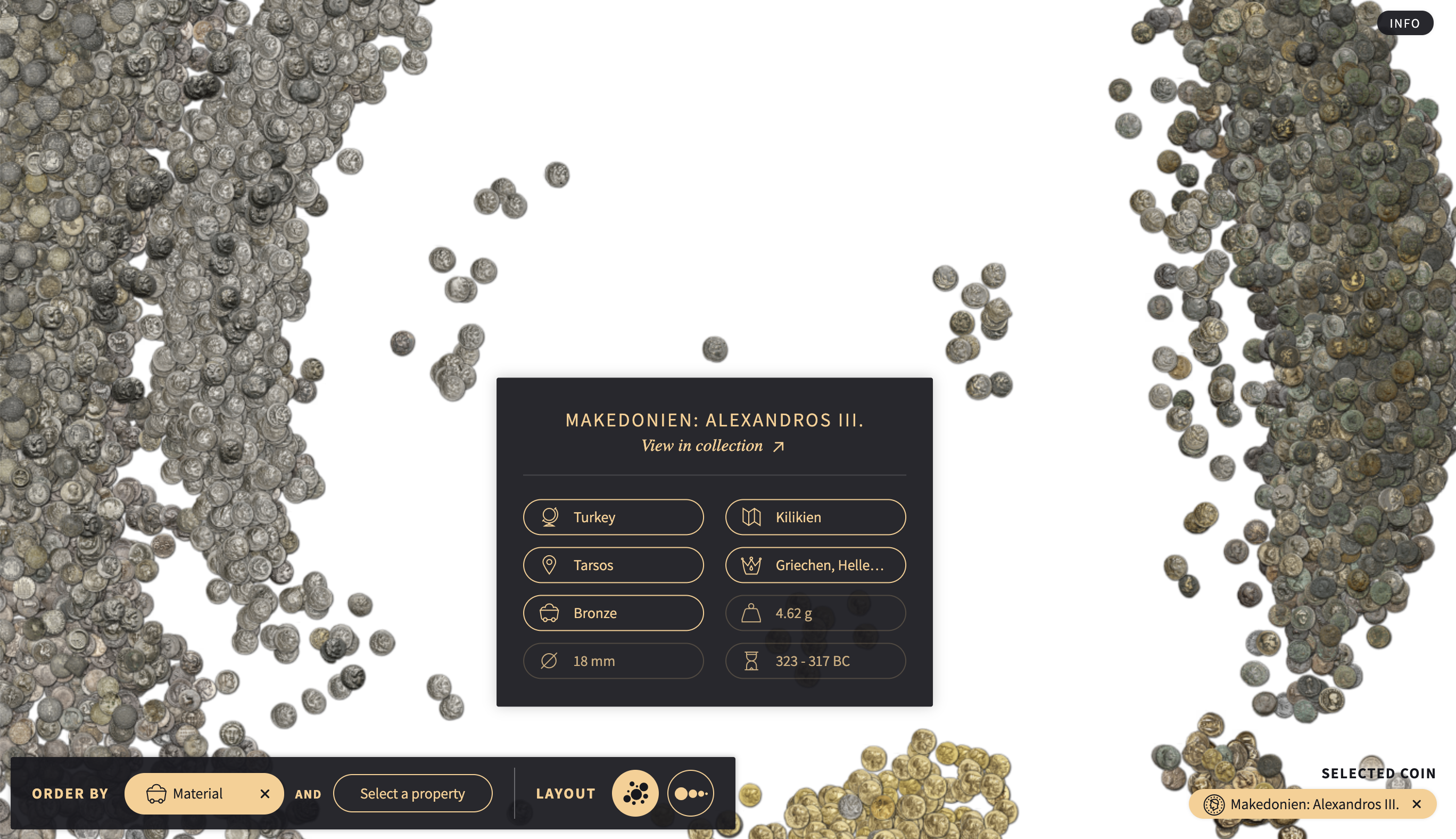
Another hub of experimental art applications is the Library of Congress’s LABS. Their initiatives are quite diverse, including the highly anticipated Citizen DJ, which will produce hip-hop music from the library’s online collection (to be released this summer), and the multi-media story, Southern Mosaic, which documents a trip in 1939 that recorded southern folk music.
实验艺术应用的另一个中心是国会图书馆的LABS 。 他们的计划非常多样化,其中包括备受期待的《 公民DJ》 ,它将通过图书馆在线收藏(将于今年夏天发行)制作嘻哈音乐;以及多媒体故事《 南方马赛克》 ,记载了1939年的一次旅行,记录南方民间音乐。

Using recordings of music interwoven with text, photos of the journey, and data visualizations, Southern Mosaic provides a rather holistic exhibition-like experience, with a little something for everyone. Then there’s everything that Jer Thorp did for the Library of Congress, such as A Library of Colors, where mousing over a color triggers a particular piece in the collection.
使用与文本交织的音乐录音,旅途照片和数据可视化,Southern Mosaic提供了一种相当整体的,类似于展览的体验,并且为每个人提供了一些东西。 然后, 杰尔·索普(Jer Thorp)为国会图书馆所做的一切,例如“色彩图书馆” ( A Library of Colors) ,将鼠标悬停在某个色彩上便触发了该收藏中的特定作品。
This tactic of visualizing collections with color to make interactive pages seems to be a common technique: The Library of Congress has another application, The Library of Congress Colors, where visitors view the color palette of a given collection and each piece within it before being exposed to the work it is referencing. Then there’s Art Palette, from Google Art & Culture, with a similar approach to the latter, but it stems from a given color palette, displaying corresponding pieces, and finally my personal favorite from the Barnes Foundation, which allows users to specify space, lines, and light, in addition to color while filtering through the collection. In the above cases, color is the obvious story thread, though each site has its own emphasis. Look through the following pictures, or try the websites for yourself, and try to notice their differences and how these techniques serve to guide you through the collection. How do these added features change your experience from V&A’s searchable collection?
这种用颜色可视化集合以创建交互式页面的策略似乎是一种常见的技术:国会图书馆还有另一个应用程序, 即国会图书馆颜色 ,访问者可以在浏览给定集合及其内部的每个部件之前查看其调色板。它正在引用的工作。 然后是Google Art&Culture的Art Palette ,与后者的处理方法类似,但是它来自给定的调色板,显示了对应的作品,最后是我个人最喜欢的Barnes Foundation ,它允许用户指定空间,线条,以及光线,以及通过集合过滤时的颜色。 在上述情况下,色彩是显而易见的故事线索,尽管每个站点都有其自身的重点。 浏览以下图片,或自己尝试使用网站,并尝试注意它们之间的差异以及这些技术如何指导您完成收藏。 这些新增功能如何改变V&A可搜索产品系列的体验?


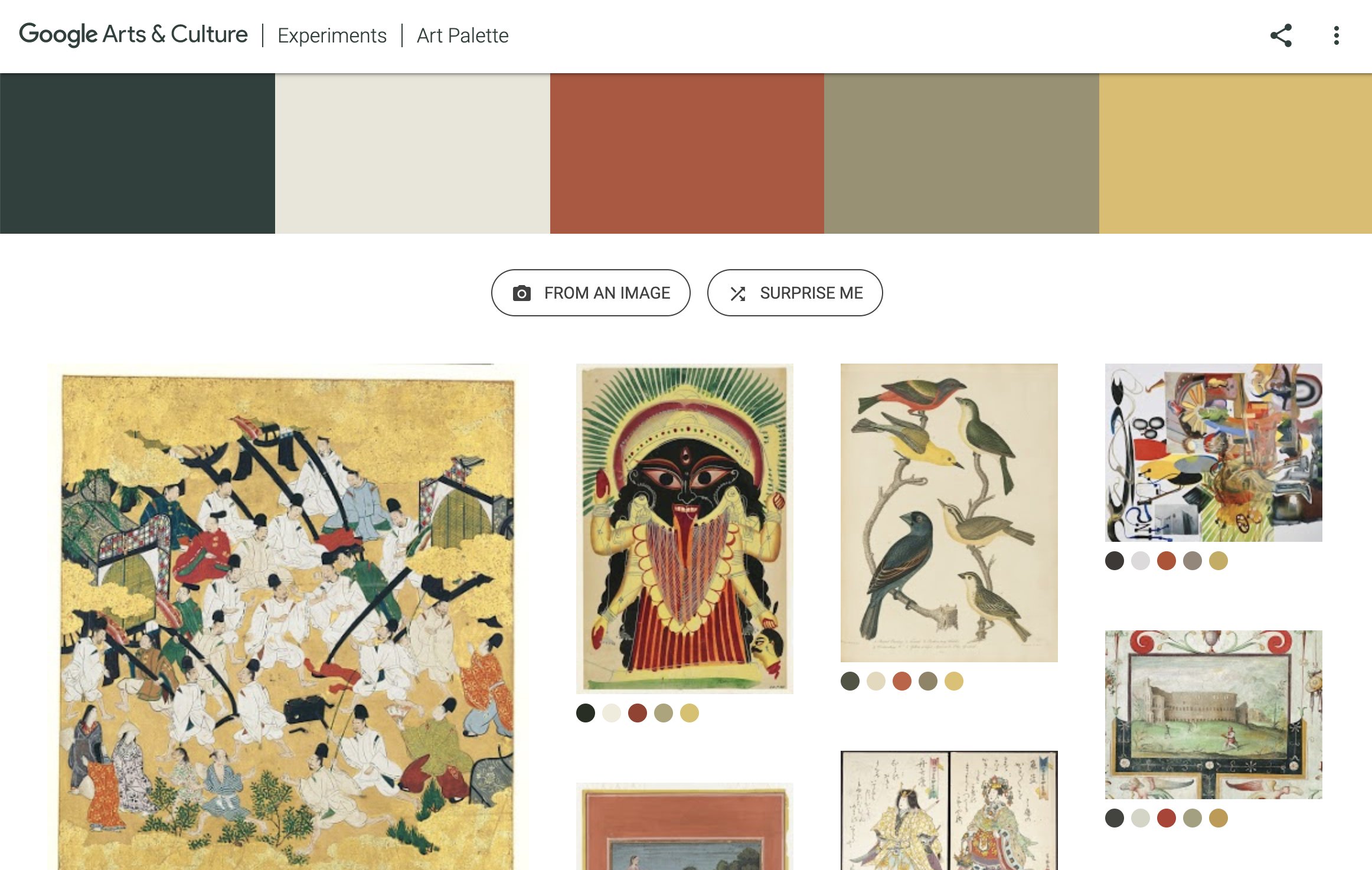
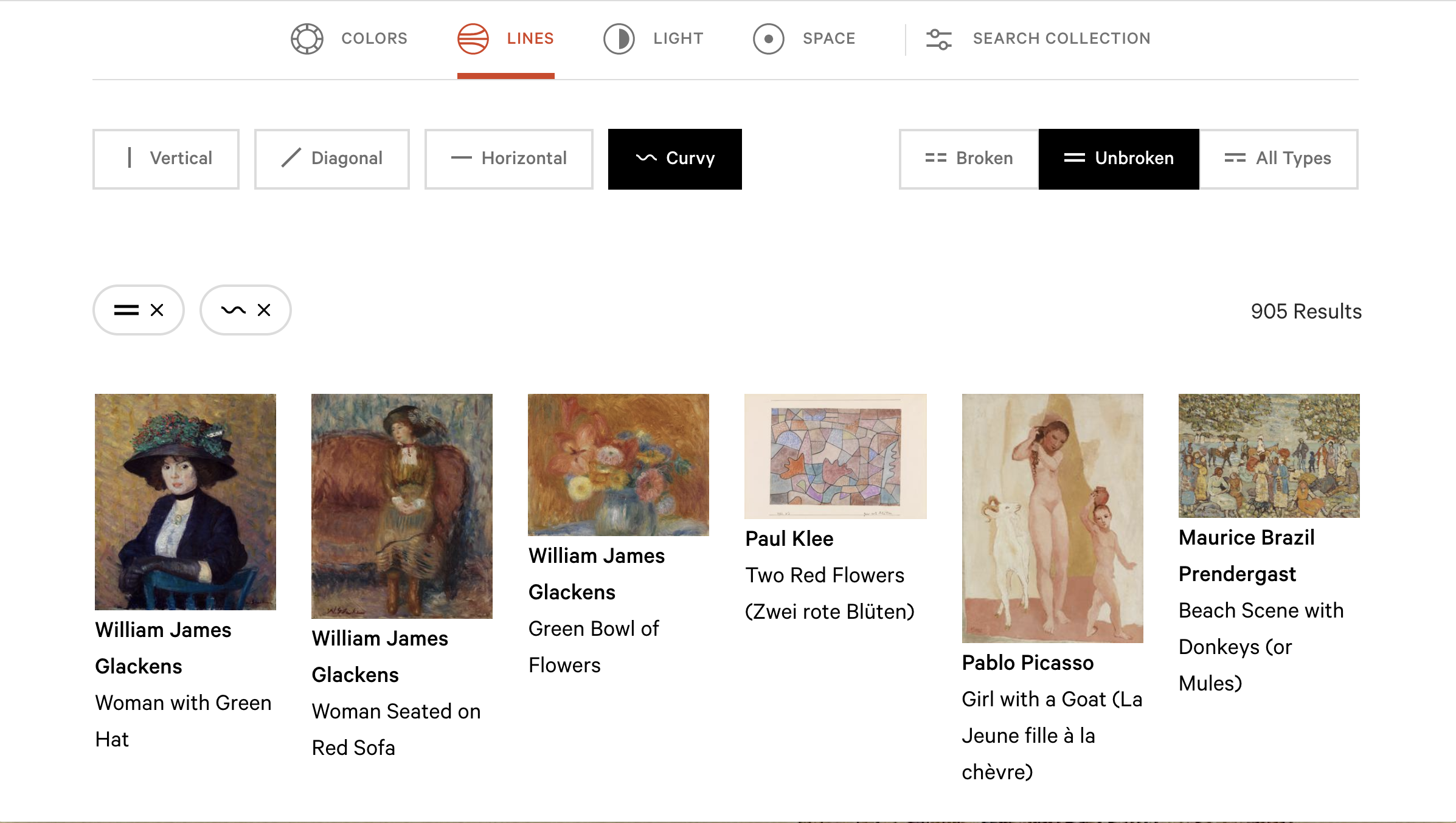
Museums have also taken a more blatant data visualization approach when portraying their online collections. Timelines and histograms are often used, such as the timeline used the Australian Centre for Contemporary Art, or the color histogram for Tate.
博物馆在描绘其在线馆藏时也采取了更为公然的数据可视化方法。 通常使用时间轴和直方图,例如时间轴用于澳大利亚当代艺术中心 ,或颜色直方图用于泰特 。
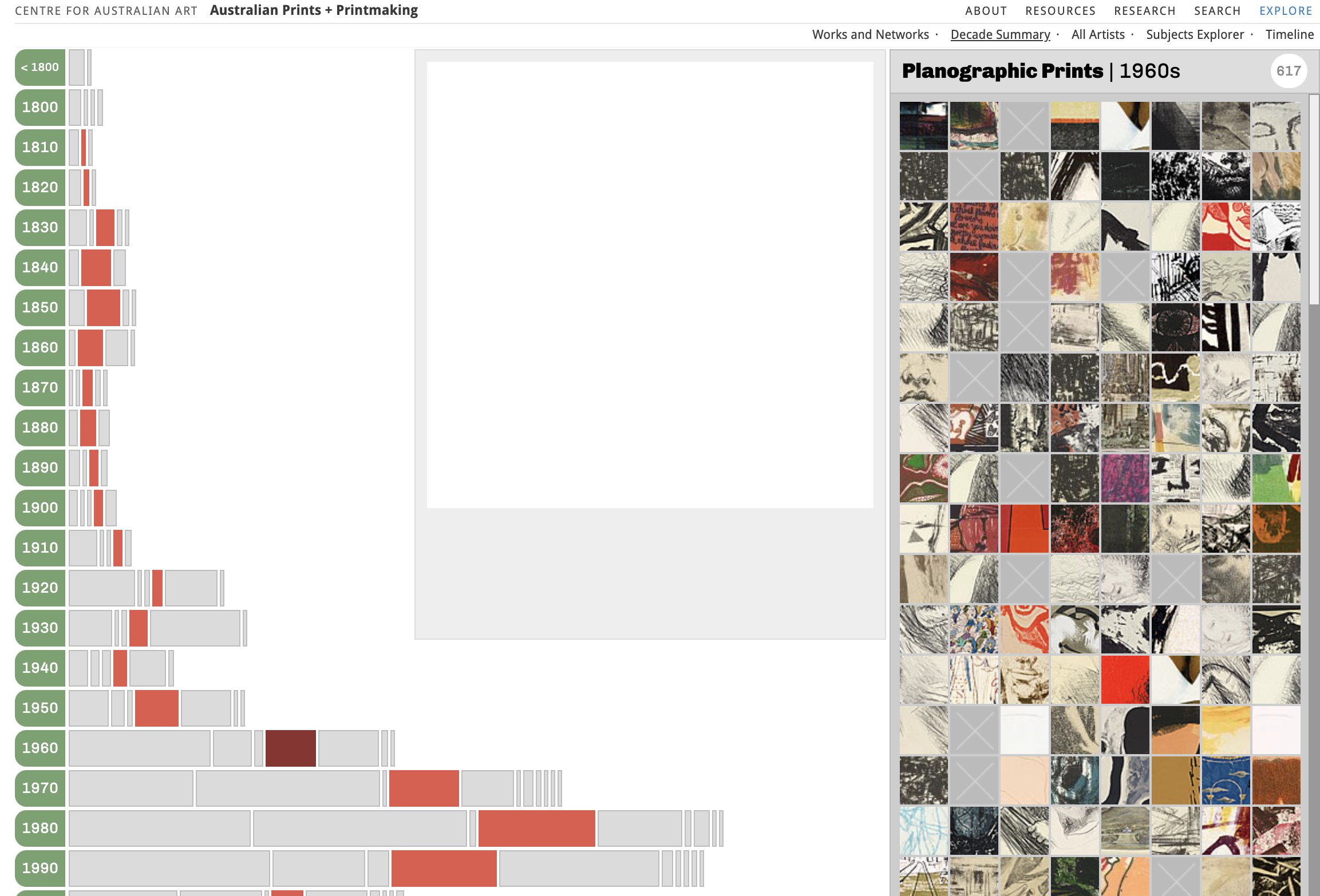
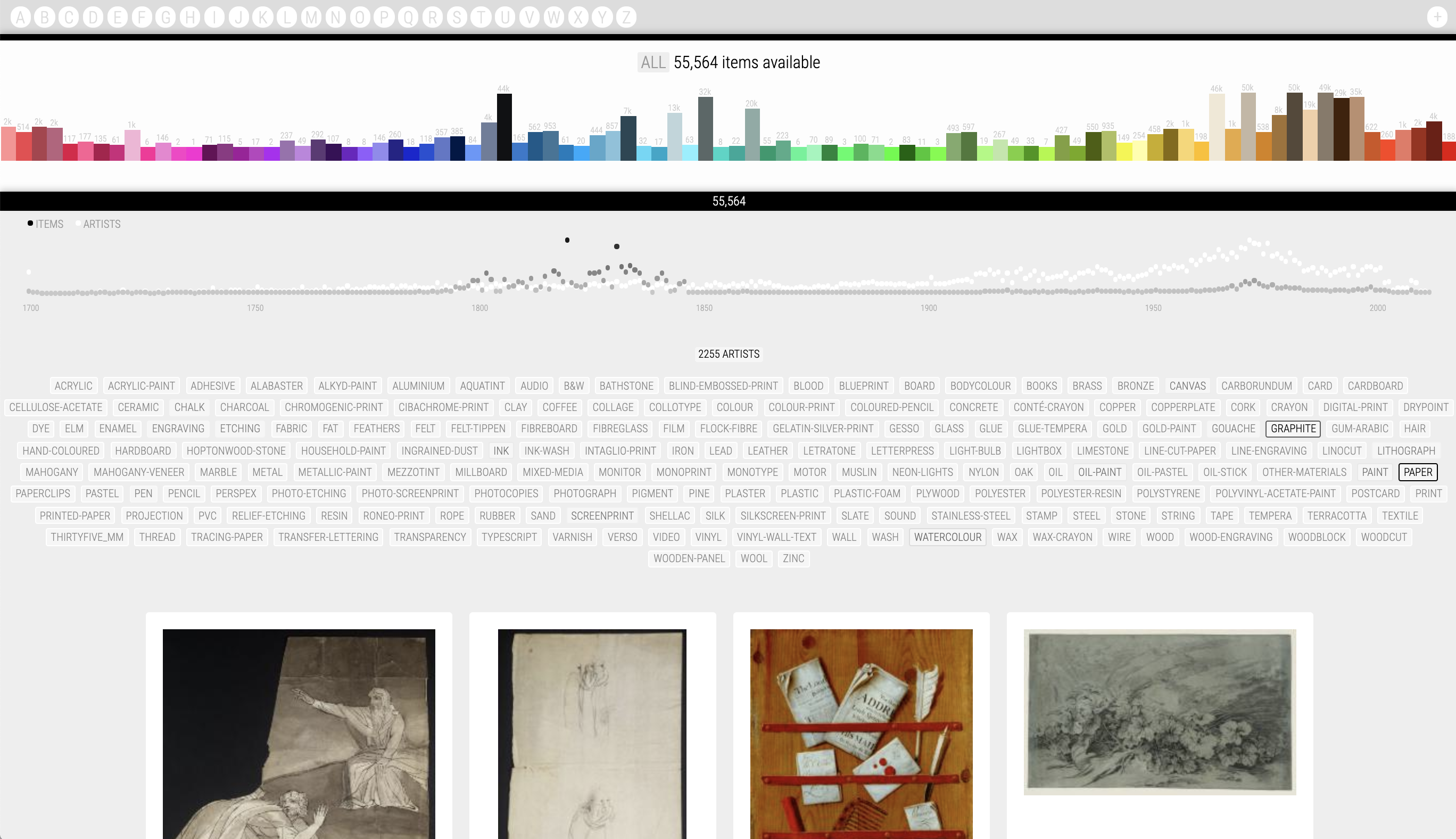
The above experiences seem to be especially suited to the internet and what we can produce from it. Like exhibitions, they weave a curated story that follows a common thread. Showcasing a bare-bones digital collection is convenient for researchers, or those looking for a specific piece, but there’s less “fun” involved for regular visitors — there’s no story thread or focus. Consequently, it’s easy for the viewer to feel overwhelmed and lost. While first steps to develop more interactive digital collections seem to focus on chronology or color, other methods of filtering collections could unfold, such as we saw earlier in “Beyond Scrolls & Screens,” which narrows in on specific objects, illustrating their appearance in each panel. I could also foresee categorizations from mediums used up to the age of the artist when it was produced. You never know what connections you’ll find, unless you try.
以上经验似乎特别适合于互联网以及我们可以从中获得的收益。 像展览一样,他们编织的策展故事遵循共同的思路。 对于研究人员或正在寻找特定作品的人来说,展示一个简单的数字馆藏很方便,但是对于普通游客来说,“乐趣”涉及的更少—没有故事线索或重点。 因此,观众很容易感到不知所措和迷路。 虽然开发更多交互式数字馆藏的第一步似乎集中在时间顺序或颜色上,但是其他过滤馆藏的方法可能会展开,例如我们在前面的“超越卷轴和屏幕”中看到的,该图缩小了特定的对象,说明了它们在每个对象中的外观。面板。 我还可以预见从使用年代到创作者年龄的各种分类。 除非您尝试,否则您永远都不知道会找到什么连接。
My hope is that by digitalizing collections and making them open-sourced, more initiatives such as Experiments with Google and LABS from the Library of Congress will ensue, thus producing unique, digital curated experiences of art. Given the output and initiatives delineated above, it’s clear that data visualization tools have been used for their design, whether or not the developers were aware of it themselves — developers might continue borrowing tools and techniques from data visualization storytelling until their products are one and the same.
我的希望是,通过对馆藏进行数字化处理并使其开源化,将会有更多的举措,例如国会图书馆的Google实验和LABS实验,从而产生独特的,数字化的艺术品策划体验。 根据上面描述的结果和计划,很明显,无论开发人员是否意识到数据可视化工具已用于他们的设计中,开发人员可能会继续从数据可视化讲故事中借鉴工具和技术,直到他们的产品成为现实。相同。
I expect museums to continue to adopt a digital strategy that embraces interactive visualizations, and even exhibition scrollytelling (like here), which would have suited pages like Southern Mosaic rather well. Such endeavors would not only relieve our boredom when museums are closed but these visualization tools could lead to original narratives during the physical exhibition development process as well.
我希望博物馆将继续采用包含交互式可视化甚至是滚动展览的数字策略(如此处所示 ),该页面将很好地适合“ Southern Mosaic”这样的页面。 这些努力不仅可以缓解博物馆关闭时的无聊感,而且这些可视化工具也可以在实体展览的开发过程中产生原创性的叙述。
一些数字博物馆体验 (A few digital museum experiences)
For interactive experiences:
对于互动体验:
The Museum of the World
世界博物馆
The Color Hunt
猎色
Beyond Scrolls & Screens
超越卷轴和屏幕
Labs from the Library of Congress
国会图书馆的实验室
Visualizing Cultural Collections
可视化文化收藏
Audio-based experiences:
基于音频的体验:
Digital DJ (says “Coming Summer 2020”)
数字DJ (说“即将到来的2020年夏季”)
The MET audio guides
MET音频指南
VR Tours:
虚拟现实之旅:
VersailleVR: the Palace is yours
VersailleVR:宫殿在您身边
The Dawn of Art: a journey through the Chauvet cave.
艺术的黎明:穿越Chauvet洞穴的旅程 。
A good resource for online exhibitions, and tours, to be filtered through at your leisure.
在线展览和旅游的良好资源 ,您可以随时通过它过滤掉。

翻译自: https://medium.com/nightingale/museums-are-going-digital-and-borrowing-from-data-viz-in-the-process-b5e3828b4000
借用继承





